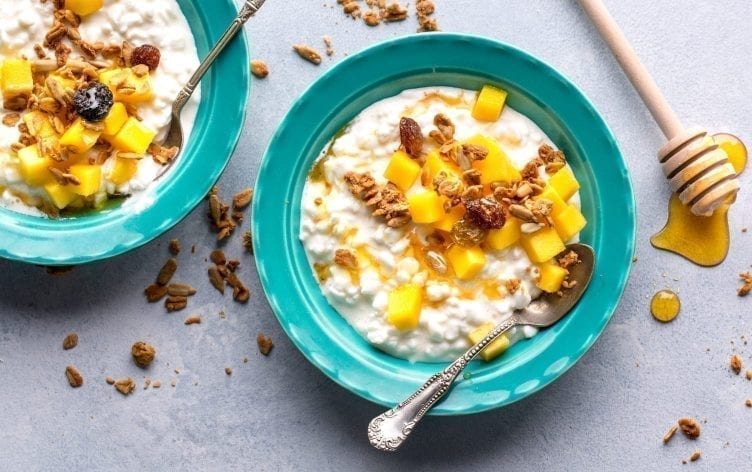
Healthy eating is a year-round thing, but January is often the time we take stock of our habits and commit to changing them for the better. This can be a positive thing, since motivation is contagious and taking care of yourself is always a great goal. The best way to lose weight and keep it off doesn’t involve quick fixes or extreme, short-term diets. It’s about small, sustainable tweaks that eventually lead to major change.
To help you change your eating habits for the better in 2019, we asked registered dietitians to suggest small, but impactful, things you can do to eat healthier this year.
1
SWAP A SUGARY TREAT FOR FRUIT
“Instead of trying to focus on what you shouldn’t be eating, focus on what you can add,” says Nazima Qureshi, RD. “This shift in perspective makes healthy eating more positive.” For example, instead of vowing to cut out sugar, Qureshi suggests shifting the focus to adding a piece of fruit to your snack routine and letting that replace a sugary packaged snack.
2
DRINK AT LEAST 64 OUCES OF WATER A DAY
Rather than focusing on cutting out soda or caffeine, make it your goal to drink at least 64 ounces of water a day. The exact amount of water you need varies based on your height, weight and activity levels, but the 64-ounce baseline is a good place to start.
Staying hydrated is important for overall health and weight loss. Plus, it’s likely upping your water intake will crowd out other beverages, like soda and coffee.
3
COOK MORE AT HOME
“You don’t have to make all your meals at home to be healthy — even just cutting back on eating out from seven times a week to two or packing your lunch instead of eating out, can make a huge difference to your health,” says Liz Hurley, RD. When we eat out we often forget about the added fat, sodium and large portion sizes, while at home these are things we often control, adds Hurley.
To make this measurable, commit to cooking a certain number of lunches and dinners at home every week. Be realistic: If you’re someone who used to order takeout for every meal, start by adding just a handful of homemade meals into your routine, then gradually work from there.
4
TRACK YOUR MACROS
“We often don’t pay any attention to what we put in our mouth, how much we are eating, or how it makes us feel,” Hurley says. “Being aware of what you are eating and evaluating your habits can go a long way toward achieving your goals.” Using an app such as MyFitnessPal to log meals and track your macros can be a great tool to help you make long-term changes to your eating habits. For example, by logging my meals, you might see patterns — whether you’re not eating enough or are overdoing it on a certain food.
Even if counting calories or tracking macros doesn’t seem like something you could do long-term, commit to doing it for a week so you have a better picture of your overall eating habits. Then, it will be easier to identify a few easy changes or swaps you can make.
5
GET A SERVING OF PROTEIN AT EVERY MEAL
Whether your goal is to lose weight or just to feel better, protein is an essential component to a healthy diet. It helps maintain muscle mass, build new muscle and keeps us satisfied for longer, explains Erik Bustillo, RD.
Figure out how much protein you need per day (use this guide), then split that number into meals and snacks to give yourself a target for each one. Plan each meal around the protein you’ll be eating.
6
EAT FIVE SERVINGS OF VEGETABLES PER DAY
As well as getting enough protein, Bustillo stresses the importance of vegetables. If you’re trying to lose weight, high-fiber vegetables can help fill you up for relatively few calories. Even if weight loss isn’t your goal, vegetables are nutrient-rich and important for overall health. Plus, filling up on vegetables may unwittingly lead to eating fewer not-so-healthy foods.
One cup of leafy greens or a 1/2 cup of other veggies counts as a serving. Try adding them to your favorite smoothies, soups and sandwiches.
7
OPT FOR WHOLE GRAINS OVER REFINED
While all carbohydrates give us energy and can be a part of a healthy diet, the complex carbs found in whole grains are slower to digest than the simple carbs found in refined grains. Plus, they pack a bigger nutrient punch. “In addition to providing glucose (which gives us energy), complex carbohydrate foods provide vitamins, minerals and fiber that are important to overall health,” says Germaine Guy, RD.
Aim for at least 2/3 of your total grain intake to come from whole grains. Try them in everything from pancakes to egg sandwiches.
8
EAT PROBIOTIC-RICH FOODS ONCE A DAY
You’ve likely heard of probiotics, healthy bacteria found in fermented foods that feed healthy bacteria in your gut. “We have more bacterial cells in our bodies than human cells,” says Bonnie Taub-Dix, RD. “The gut really dictates so much about your state of health and how well your immune system functions, so feeding the good bacteria can have a positive impact.
Taub-Dix recommends eating at least one serving of probiotic-rich fermented food each day. Greek yogurt, kimchi, pickles, tempeh and miso paste are all great sources that you can learn more about here.
9
TRY MEATLESS MONDAY
You don’t have to cut out meat completely to reap the benefits of plant-based meals. “Even if one day a week you swap out meat, that alone can be a benefit,” says Taub-Dix. Meatless meals centered around vegetables, whole grains and plant-based protein sources like beans, legumes and soy tend to be higher in fiber and nutrients than meat-centric meals, says Taub-Dix and also slightly lower in calories.
“We have a tendency to feel like meat must be the main dish, but you don’t have to become vegetarian to eat meatless every now and then.” Go meatless once or twice a week or just commit to eating a certain number of meatless meals each week.
10
FOCUS ON ONE CHANGE AT A TIME
All of these changes are easy enough to implement on their own, but think twice before diving into all of them at once.
“Maybe in January you drink more water, February you add vegetables to your breakfast, March you start measuring your portions sizes,” Hurley says. “We tend to have success when we focus on one small change at a time and really hone in on it until it becomes a habit, rather than doing a complete overhaul of our diet all at once. Striving to be better in small intervals helps us to make huge changes over the course of the year, and we are much more likely to keep them up for years to come.”







